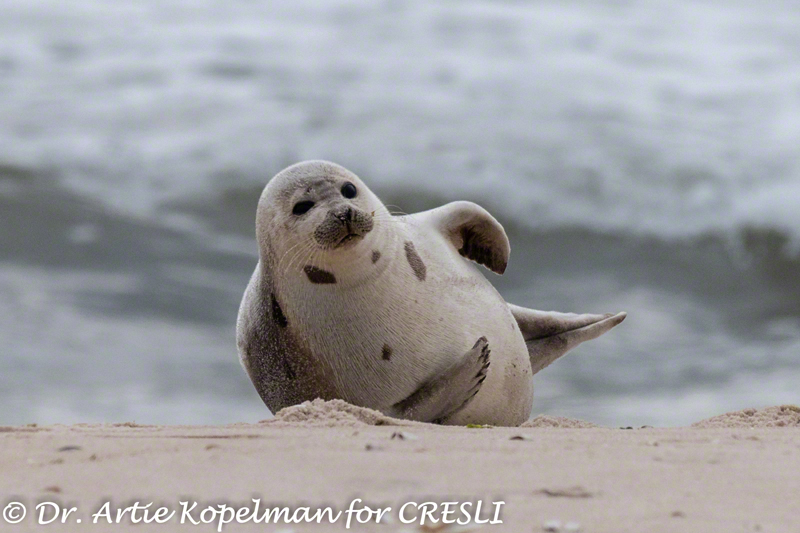Arctic Seals
(AKA: Ice seals, Ice-loving seals; Pagophylic seals)

Arctic seals spend the summeer in the high arctic. As autumn approaches, arctic seals begin to migrate to the subarctic and edges of the sea ice. For more than 30 years, some harp seals and hooded seals have extended their range southward to Long Island and beyond (some hooded seals have been found as far south as Puerto Rico). What contributes to these movements are still unclear.
Harp seal (Pagophilus groenlandicus)
The harp seal is named for the dark harp shaped pattern on its back. The dark horseshoe or harp shape is more distinct on adult males. The female is lighter and the juveniles of both sexes have a series of blotches along the back. These seals resemble the harbor seal but are slightly larger, growing to 6 feet and weighing up to 400 pounds. The harp seal's scientific name means "ice loving seal of Greenland" which is fitting for these inhabitants of the polar pack ice. Their migration roughly follows the edge of the pack ice which retreats northward in the summer and moves south in winter. Pups are born with a white coat which gives it ideal camouflage as it spends long periods of time waiting on the ice for the mother to return from feeding. The pups stay with the mother for approximately two weeks during which they almost triple their birth weight. At about this time they also shed their white coat. This excess fat sustains the young seal between the time the mother leaves and it learns to feed effectively on its own.
This species has endured intense hunting beginning with the Basques in the 16th century. During the 1700 and 1800's harp seals provided millions of barrels of oil that was shipped back to Europe where it was used mainly for lamp oil and lubricants. By the mid 20th century they were hunted mainly for their pelts which were used by the European fur industry for clothing. After Canadian Fisheries scientists discovered that the harp seal's population had become drastically reduced in the 1950's, the Government instituted quotas to reduce the killing.
Public attention became focused on this massive slaughter, particularly of the white coated pups off the coast of Newfoundland every March. Public outcry and political pressure has not diminished the hunt quotas, but has limited the markets for harp seal pup skins. Yes, supposedly the commercial hunt was ended in 1987, but the hunt for "personal use" continues. For a detailed review of the Canadian and other harp seal hunts, go to the Seal Conservation Society's harp seal page
For a review of the harp seal quotas (Total Allowable Catch or TAC) since 1952, go to http://www.harpseals.org/about_the_hunt/quota_tac.php
- About the Canadian Seal Hunt (Humane Society)
- Ending the commercial seal hunt in Canada (IFAW)
- Ending the commercial seal hunt in Canada via Seafood Boycott
Hooded Seal (Cystophora cristata)
Hooded seals are less numerous seal than harp seals, but inhabit the same regions of the world. These seals feed on fish, squid, shrimp and mussels. They are large and very distinct in appearance. Both sexes have irregular black patches on a silvery background. The males which reach up to 9 feet and weigh 900 pounds, have a very unusual nasal sac which can inflate to twice the size of a football for courtship display or if angered. In addition, there is another membrane within the nostril that can inflate to a red balloon-like sac. Hence their scientific name, "bladder carrying seal with a crest." The females are rather unspectacular compared to the male. They are somewhat smaller, about 7 feet long and weighing about 670 pounds.
Pups about 3 ½ feet long, weighing approximately 50 pounds, are born on the ice from mid-March to mid-April. Pups are born large and well developed, having shed the lanugo (birth coat) in utero. At birth their coat is a beautiful slate blue on the back and pale grey underneath, giving it the nickname "blueback." This coloring remains until molting at 14 months old when they resemble their parents' coat. The blueback pelts were extremely desirable to sealers who sold the pelts to furriers for coats. The pups stay with their mother for only 3 - 5 days before weaning, during which time they double their birth weight.
From our colleagues at NOAA Fisheries New England/Mid-Atlantic:
If you see seals on the beach, use the Rule of Thumb while watching seals to make sure you are giving them enough space.
1) Close one eye.
2) Make a thumbs up and hold your thumb so it's in line with your vision and the seal.
3) If you can see the seal from behind your thumb, you are too close so back up!
https://www.facebook.com/NOAAFisheriesNEMA/photos/a.1841106822794035/2588783844692992/
Don't forget to contact your local stranding network 631-369-9829, or the regional hotline 866-755-6622, if you think a seal needs help!





